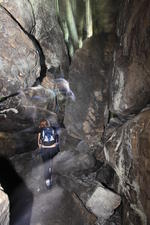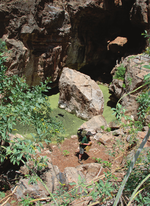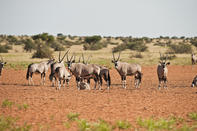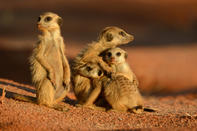Cave of Wonder

The Wonderwerk (Miracle) cave, unlike most other limestone caves, consists of just a single cavern. Although it was clearly made by water dissolving the dolomitic rock, for the past two million years the only thing that has flowed inside the 140-m cave that, and people.
The dust layer is around 4 m deep near the mouth, and archaeological digs have offered evidence of human occupation throughout. This has provided an unbroken record, not just of human occupation, but of developing human technology, from about the time of the human-ape divergence right up to the Middle Stone Age.
Indeed, evidence of the use of fire dates back about 800 000 years. In 1844, traveller Henry Methuen noted not only that there were San paintings in the cave, but that San were clearly still living in the area. For these very good reasons, it is a national heritage site. It can be found smack bang between Daniëlskuil and Kuruman.
Boesmansgat

Less than 20 km from Wonderwerk Cave is a huge hole in the ground; a water-filled cave named after the farm on which it occurs. Just what San were doing in that hole remains something of a mystery though, because it is effectively a bottomless pit that has claimed the lives of some of the world's most accomplished deep divers, Boesmansgat being the place everyone goes to see how deep they can dive. In 1995 Deon Dreyer went in and didn't return.
The first attempts to find his body failed, but in 2004 Dave Shaw, while testing new re-breather equipment, located Dreyer's body on a rubble slope 270 m down. A year later Shaw returned with Don Shirley to recover the body, but he too died due to the technical failure of his equipment. The two bodies, wrapped together by their safety lines, later floated to the surface. None of this has stopped deep divers from trying their luck with cave diving, however. The world cave-diving record, set in 1996 for a 2826-m dive by Nuno Gomes, was gained in Boesmansgat.
Nature Activities
The Hotazel Road (Rd) Bird Sanctuary is a 2 000 hectare nature reserve situated on the northwest side of Kuruman. It has a wetland area with plenty of grass, reeds and trees. There are about 115 different species of birds mainly from the duck, ibis and heron families.
A wide variety of indigenous game can be viewed at the reserve, including giraffe, eland, gemsbok, blue wildebeest, waterbuck, kudu, red hartebeest, impala, blesbok, springbok, ostrich, black-backed jackal and caracal (lynx). The camel-thorn, wild sage and umbrella-thorn are the main tree species in the reserve.
Kuruman is also home to the Kalahari Hunters’ Association, and the abundant game bred and culled in the area is fast turning it into a hunter’s Mecca. You can tour the mines in the Kuruman area, like the spectacular tunnels and rock formations of Black Rock’s worked-out manganese mine.
Tswalu Kalahari Reserve is close to Kuruman, and is the largest privately owned game reserve in South Africa. The name Tswalu means ‘new beginning’ in the Tswana language. The reserve has over 70 species of mammals and more than 200 bird species. Activities include horse-riding through the reserve and game-drives, conducted in open sided, canopied safari vehicles. Bush walks, led by experienced field guides, give insight into the local vegetation, bush medicines, cosmetics and hunting skills of the San people.

